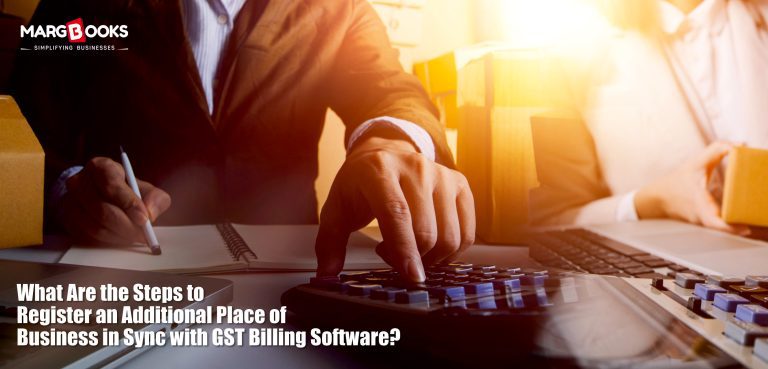Running a business is no longer just about having a single storefront. With expansion becoming the new norm—be it warehouses, branch offices, or godowns—it’s essential to comply with GST laws. One key requirement under India’s Goods and Services Tax system is declaring every location involved in business operations. This is known as registering an additional place of business in GST.
If you’re a growing enterprise or even a small business stepping into multiple locations, knowing how to add these places in your GST profile is crucial. And when you’re managing billing and compliance through a reliable GST Billing Software like MargBooks, the process becomes even more seamless.
In this blog, we’ll walk you through all the steps to register your additional place of business in sync with your GST billing software—so that you stay compliant and confident.
Understanding the Importance of Registering an Additional Place of Business in GST
Let’s start with the basics. Under GST rules, if you’re operating from more than one location within the same state or union territory, you must declare each one as an additional place of business. This ensures all activities are transparent and every location is authorized to issue invoices.
Why does this matter?
- It avoids legal hassles during inspections.
- It ensures your business stays compliant.
- It enables location-based invoicing using GST Billing Software.
- It helps you claim Input Tax Credit (ITC) correctly.
So, whether it’s a new warehouse, an office branch, or even a temporary kiosk, you need to register it under your GST profile.
Steps to Register an Additional Place of Business in GST
Here’s a step-by-step guide to help you update your GST profile online and sync it with tools like MargBooks.
Step 1: Login to GST Portal
Start by visiting the GST portal and log in with your valid GST credentials (username and password).
Step 2: Navigate to Amendment of Registration
- After logging in, go to Services > Registration > Amendment of Registration (Non-Core Fields).
- This section allows you to modify business details that don’t require GST officer approval, like adding another location.
Step 3: Choose ‘Additional Places of Business’ Tab
- Click on the ‘Additional Places of Business’ tab on the left side of the screen.
- If you have already added some locations earlier, they will be visible here.
Step 4: Add New Business Location Details
- Click on ‘Add New’ to fill in details of your new location.
- You will need the following:
- Address of the new place
- Nature of possession (owned, rented, leased, consent, etc.)
- Supporting document (such as electricity bill, rent agreement, NOC, or property tax receipt)
- Nature of business activity (storage, trading, office, warehouse, etc.)
Step 5: Upload Documents
Make sure you upload clear and valid documents proving the use of the new premises. Common acceptable documents include:
- Rent agreement or lease deed
- NOC (if not owned by the applicant)
- Utility bill not older than three months
Step 6: Verification and Submission
- Once you’ve entered and uploaded all information, verify using Digital Signature Certificate (DSC), e-Sign, or Electronic Verification Code (EVC).
- Submit the form.
You’ll receive an Acknowledgement Reference Number (ARN) to track the application status.
How to Sync the New Business Location with GST Billing Software like MargBooks
Once your additional place of business is officially added to your GST profile, the next important step is updating it in your GST Billing Software, like MargBooks.
Why Sync with MargBooks?
MargBooks is one of the leading cloud-based GST Billing Software solutions in India. It offers:
- Real-time invoice generation
- Multi-location billing support
- Auto-fetching of GST details
- Integrated GSTR reports
To update your new business location in MargBooks:
- Log in to your MargBooks dashboard.
- Navigate to Company Settings > Branches/Locations.
- Add the new branch with the same address and GSTIN as updated in the GST portal.
- Assign users, billing access, and inventory controls for the new location.
- Save and sync.
Once done, you’ll be able to generate GST-compliant invoices from your new location and ensure seamless tax reporting.
Common Mistakes to Avoid
While the process seems straightforward, avoid these common errors:
- Using incomplete address details – Make sure you match exactly what’s in your property documents.
- Forgetting to update software – Not syncing with your GST billing software can cause incorrect invoice headers or wrong GSTN mapping.
- Not maintaining supporting documents – During audits, you may be asked for proof of the additional location.
Final Thoughts
Adding an additional place of business in GST is not just a compliance formality—it’s a smart move that sets the foundation for expansion and smoother business operations. With modern tools like MargBooks GST Billing Software, this process becomes hassle-free and efficient.
Whether you’re expanding to a new city or simply opening a new warehouse, always update your GST registration accordingly and ensure your billing software reflects the changes. It saves you time, protects you from penalties, and keeps your financials crystal clear.
Need help managing GST invoices from multiple locations?
Explore MargBooks today and make your GST compliance smoother than ever.




